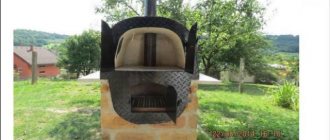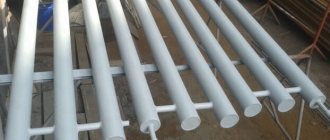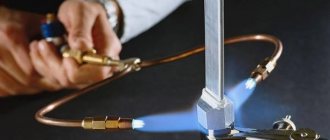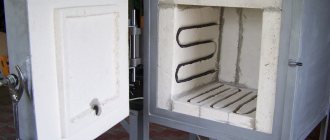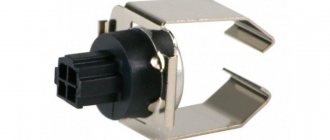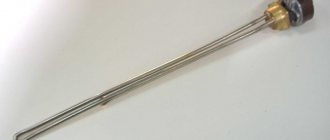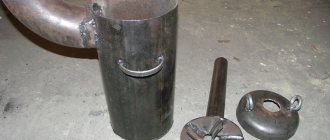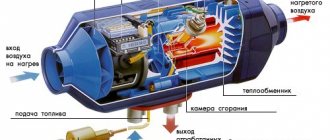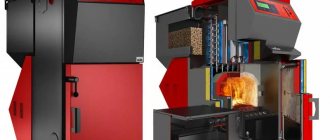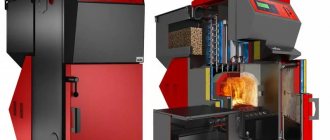How it works?
A standard Peltier element is a plate with two outputs for connecting to the network, assembled from cubes of different metals, for example copper and constantan, copper and nickel, lead and constantan, etc.
The plate passes electric current through itself and heats up on one side, and on the other hand it becomes cold.
The presented electric generator uses the opposite principle: one side of the element is heated by burning fuel (in this case, wood chips and firewood), the other is cooled by any heat exchanger - liquid or air, and a constant electric current is generated on the wires, which can already be used at your discretion.
One cannot expect high power levels; even in factory furnace-generators (they usually have two elements), up to 60 W are generated. Homemade ones typically output 5 W (enough to charge a cell phone or power an LED flashlight).
The electric current in such a stove is only a by-product; the main energy from the combustion of wood is not wasted, but is used to heat the room (enough for a small house, cottage or tent).
Conclusions and useful video on the topic
The following video will provide additional information on the topic:
Gas heat generators for heating systems are a highly efficient and economically feasible solution. Due to safety, reliability and ease of operation, the equipment can be used in residential buildings and industrial facilities.
If a gas heat generator is installed in your home, you have additional information about the advantages and disadvantages of the equipment, or you know which generator is best to purchase for heating a private home, share your experience and knowledge with readers in the comments.
Peculiarities
Indigirka is a multifunctional device, which is a symbiosis of a long-burning wood stove and a thermal electric generator capable of producing electricity.
The compact and lightweight stove can be easily transported and installed not only indoors, but also used outdoors. The device can operate at temperatures from +40 to -30 ° C.
The spacious hob can accommodate several types of cookware (cook soup, heat tea, etc.). The electricity generated by the stove is quite enough to connect a portable TV, radio, 1-2 light bulbs, and charge the power supply of a mobile phone, laptop or video camera.
Air heating
Air heating is required to maintain a comfortable temperature during the cold period. And what exactly this temperature is is described in GOST 30494-96. So, for residential premises the norm is +20 degrees, for corner living rooms - +22 degrees. For the kitchen - +18 degrees, the bathroom - +25 degrees, and the toilet - +18 degrees. Note that such standards are suitable for apartment buildings.
The power calculations that designers usually rely on when creating air heating and ventilation give fairly average values - and it will be difficult to accurately determine heat leaks. In addition, they change depending on the current temperature, wind and humidity outside.
Components of air heating
But for quite a long time there has been a methodology that can be based on in the case of independent design. The instructions here are quite simple: for 1 cubic meter of room you need 40 W of thermal power. We add 100 W of heat to each window opening. For each door that leads to the street - 200. The coefficient for corner apartments is 1.2-1.3, for private houses - 1.5. A regional coefficient is also applied: 0.7-0.9 for warm regions, 1.2-1.3 for the European part of the Russian Federation, 1.5-2.0 for the Far North and Far East. When the temperature outside is warmer, in order to regulate the temperature in the house without opening the windows, you can replace the radiator valve with a throttle or thermostatic head.
Classic version
As noted, a wood-fired power plant uses several technologies to produce electricity. The classic one among them is steam power, or simply the steam engine.
Everything is simple here - wood or any other fuel, when burned, heats up the water, as a result of which it turns into a gaseous state - steam.
The resulting steam is supplied to the turbine of the generating set, and due to rotation, the generator generates electricity.
Since the steam engine and generator set are connected in a single closed circuit, after passing through the turbine the steam is cooled, fed back into the boiler, and the whole process is repeated.
This power plant scheme is one of the simplest, but it has a number of significant disadvantages, one of which is the danger of explosion.
After water passes into a gaseous state, the pressure in the circuit increases significantly, and if it is not regulated, there is a high probability of rupture of the pipelines.
And although modern systems use a whole set of valves that regulate pressure, the operation of a steam engine still requires constant monitoring.
In addition, ordinary water used in this engine can cause scale to form on the walls of the pipes, which reduces the efficiency of the station (scale impairs heat transfer and reduces the throughput of the pipes).
But now this problem is solved by using distilled water, liquids, purified impurities that precipitate, or special gases.
But on the other hand, this power plant can perform another function - to heat the room.
Everything is simple here - after performing its function (rotation of the turbine), the steam must be cooled so that it turns into a liquid state again, which requires a cooling system or, simply, a radiator.
And if you place this radiator indoors, then in the end we will receive not only electricity from such a station, but also heat.
Rules for the safe use of guns
It is no secret that all home-made devices are objects of increased danger, because improper design and assembly can cause fire, electric shock and other troubles.
But most accidents occur not so much due to design errors, but rather due to simple neglect of safety measures.
Heating with heat guns is a popular technique in the cold season, but it is important to ensure a uniform flow of heat and prevent frozen car parts from touching the hot heater elements
Let us recall the basic operating rules:
- All direct heating heat guns can only be used if there is good (preferably forced) ventilation. But even in such conditions, staying longer than a couple of hours in a room with a direct-flow diesel or gas gun is fraught with headaches and other symptoms of poisoning.
- The body of the gun (especially if it is made of metal) gets very hot during operation, because, unlike factory models, homemade devices are not equipped with heat-insulating layers inside the casing. Therefore, it is important to take care of a stable base, which will prevent the cylinder from spontaneously rolling, and a handle that does not heat up.
- The “barrel” of units with open burners should be covered with a protective mesh screen, and it is advisable to equip the electric gun with grounding.
- Never direct hot air towards fuel cans or gas cylinders. And in general, the distance from the hot air outlet to the nearest object should be at least 2 meters.
- To ignite the burner in a gas and diesel gun, use a special lighter with a long handle.
- Before turning off, let the fan run without fuel for a few minutes so that it can cool the device.
And lastly, no matter how confident you are in the quality of the assembly and the safety of the connections, never leave your homemade gun to work unattended.
Engineering capabilities
The technical characteristics of power generating equipment speak for themselves:
- the optimal amount of fuel for loading is 30 liters;
- external dimensions have the following parameters: height – 652 mm, depth – 427 mm, width – 540 mm;
- unit weight – 54 kg;
- the maximum size of a heated structure is 50 m³;
- chimney diameter – 80.0 mm;
- the smallest chimney height is 3.0 meters;
- number of chimney pipes - 9 pieces per set;
- combustion compartment – 41 dm³;
- thermal power – 4 kW;
- output power – 50 W (min);
- output voltage – approximately 12 Volts;
- firebox door size – 178 mm in diameter;
- heating surface – 0.6 sq. m;
- type of fuel - brown coal, peat, firewood from deciduous trees, fuel briquettes, pallets.
It is important to know: it is strictly forbidden to use coal as a combustible material.
Thermoelectric generators
Power plants with generators built according to the Peltier principle are quite an interesting option.
Physicist Peltier discovered an effect that boils down to the fact that when electricity is passed through conductors consisting of two dissimilar materials, heat is absorbed at one of the contacts, and heat is released at the other.
Moreover, this effect is the opposite - if the conductor is heated on one side and cooled on the other, then electricity will be generated in it.
It is the opposite effect that is used in wood-fired power plants. When burned, they heat up one half of the plate (it is a thermoelectric generator), consisting of cubes made of different metals, and the second part is cooled (for which heat exchangers are used), as a result of which electricity appears at the terminals of the plate.
But such a generator has several nuances. One of them is that the parameters of the released energy directly depend on the temperature difference at the ends of the plate, therefore, to equalize and stabilize them, it is necessary to use a voltage regulator.
The second nuance is that the energy released is just a side effect; most of the energy when burning wood is simply converted into heat. Because of this, the efficiency of this type of station is not very high.
We recommend: Gas double-circuit boiler: what is it, single-circuit or double-circuit, with a boiler
The advantages of power plants with thermoelectric generators include:
- Long service life (no moving parts);
- At the same time, not only energy is generated, but also heat, which can be used for heating or cooking;
- Quiet operation.
Wood-burning power plants using the Peltier principle are a fairly common option, and they produce both portable devices that can only release electricity to charge low-power consumers (phones, flashlights), and industrial ones that can power powerful units.
Briefly about the main thing
Modern models of wood-burning gas generators are so effective that they can even be installed on a car. However, in most cases, it is a successful way to save on fuel for remote areas where, apart from firewood, there are no other types of energy resources, and delivering them there is unprofitable. Simplified, the unit consists of a housing, a loading chamber, a firebox and an ash pan. Its operating principle is based on the thermal decomposition of wood or coal at low oxygen levels, and subsequent reduction to carbon monoxide and hydrogen.
Flue gases are cooled, purified and mixed with oxygen before entering the internal combustion engine. The main advantages of gas generators of this type:
- Great efficiency.
- Up to 25 hours of burning per load.
- Complete burning of wood.
- Power adjustment.
- No harmful emissions.
- Economical.
- Possibility of using raw wood.
- Operation on other types of fuel.
- Safety.
- Large chamber volumes.
The disadvantages are manifested in the high cost, energy dependence of modern models, the possibility of clogging, gas temperature control, manual loading, and the need to use dry fuel. In this case, there are 3 varieties - direct, reverse and horizontal. Each of them has its own pros, cons and application features. The installation of the unit must be carried out in accordance with the regulations.
Description and design characteristics
The Indigirka heating, electricity-generating cooking stove is a simple but unique design consisting of the following elements:
- The firebox is made of heat-resistant stainless high-alloy steel (2.0 mm thick). Due to this, the air space of the object quickly warms up. The maximum volume of a heated room does not exceed 50 cubic meters. Elements not subject to temperature stress are made of one and a half millimeter structural steel.
- There are 2 thermal electric generators (TEG) 30-12 fixed on the side walls of the firebox. Using a cable, connectors for connecting electrical appliances are connected to the generator. Generators transform the heat of burning fuel into electrical energy. A stable, full-fledged operation mode of the TEG begins 10 minutes after the fuel is ignited.
- The firebox door can open 140 degrees. A window made of heat-resistant glass is mounted on the door, through which the fuel combustion process is visually observed.
- The grate is made of heat-resistant steel alloy. Through the grate slits, ash and combustion product residues enter the movable ash pan. The model is equipped with a valve that regulates the intensity of the combustion process. The ideal fuel for a TEG stove is firewood, peat and wood chip briquettes.
- The upper part of the body is designed for heating and cooking food.
The outer surface of the Indigirka stove is covered with silicone heat-resistant enamel.
Please note: before continuous operation of the heating device, it is recommended to pre-fire the stove in the open air for an hour to eliminate the smell and smoke emitted by the enamel.
Types of air heating systems
In order to install a home air heating system that is truly ideal in all respects with your own hands, you should first familiarize yourself with its existing types. In particular, an air heating system can be classified according to several characteristics at once.
According to the principle of air circulation:
- natural - in such a system, heated air rises and moves through the air duct with a free current into the room to be heated.
- forced - air circulation in the system is carried out by introducing powerful fans into it.
Forced ventilation
By type of scale:
- local - such an air heating system for a private house is used to create the most comfortable temperature in small rooms (private house);
- central - suitable for heating large premises (warehouse, production premises, industrial workshops).
Scheme of air heating of a production room
According to the principle of heat exchange:
- supply air - air from the street is used for heating, which is drawn by a fan to the heating element;
- partial recirculation - both air from the street and cooled air from the premises are used in equal shares;
- recirculation - the air constantly circulates - it heats up, moves into the room, cools down there and heats up again.
By location:
- suspension systems;
- floor appliances.
Underfloor air heating
It is this kind of air heating of the house with your own hands that can not only heat the coolant as quickly as possible, but with the help of a fan it quickly spreads through the air duct, thus ensuring fairly rapid heating of the room. Another advantage of this system is that it can be supplemented with climate control equipment. In this case, during the hot season, do-it-yourself air heating will effectively reduce the air temperature in the rooms, thereby creating the most comfortable conditions.
If you choose an air heating system with natural circulation, then all auxiliary devices should be located in the upper part of the room
It is important to consider that no matter what type of air heating system you choose, there is only one coolant in it - ordinary air
Movement of air flows in the heating system
Pros of this generator
The simpler the design, the more reliable it is, this can also be said about the type of electricity generation presented.
There are no parts rubbing against each other that could fail. Therefore, a wood-burning generator:
- durable and reliable;
- works silently;
- uses available fuel;
- lightweight, portable - can be up to 1 kg.
The generator furnace is a know-how of recent years. It will be of interest to both amateur experimenters and travelers, fans of hiking and fishing. And who wouldn’t want to have access to electricity during a blackout?
For a homemade stove, all the parts can be bought very inexpensively - within 500 rubles. (Chinese Peltier elements can be ordered via the Internet for about 300 rubles.)
How to buy a heat generator from NORTEK?
From us you can inexpensively buy a heat generator for air heating of your premises. We will select you a reliable and high-quality heat generator made in Russia or Italy. We design, supply and install heat generators - air heaters for industrial heating throughout Russia.
To order a heat generator, call us or leave a request on the website. We will determine the required equipment configuration for you using calculation programs.
The employees of NORTEK RUS LLC have extensive experience working with air heating and will help you accurately select heat generators to solve your problem.
The period for production and delivery of equipment is 4-6 weeks.
Criterias of choice
Due to the fact that the wood-burning autonomous electric generator exists in several versions, the user’s choice is simplified. Since only a generator stove is suitable for the home, there are no other options. And large wood-burning power plants are used to supply power to industrial or civil facilities, since their power varies between 100-200 kW.
When choosing, you should take into account the size of the facility that will be served, as well as what power you should expect. To determine the amount of fuel consumption, you need to plan with what degree of efficiency and how often the device will be used, based on this, the volume of the loading container for firewood is selected.
Existing models
Fully functional, high-performance equipment such as the BioKIBOR power plant is quite expensive. If a wood-burning generator was chosen for the facility, then you can buy it within the amount of 2,000,000 rubles. By design, this is a modular installation with automatic fuel supply. To provide 100 kW equipment with firewood for one day, 5 tons (or 200 kg per hour of operation) will be required. The specified amount of fuel is required for full operation of the station.
Let's watch a video about the Indigirka wood-burning stove-generator model:
A device such as a wood-burning stove-generator (Indigirka brand Termofor) will cost the user approximately 30,000 rubles. When purchasing, the capacity of the combustion chamber is taken into account (41 liters), with a maximum load of 30 liters. To remove combustion products, a chimney is provided, the diameter of which is 80 mm and the height is 3 m. The output voltage is 12 V and the power is 60 W.
General recommendations
Wood-burning generator for charging your phone
To maintain a high temperature, it is necessary to ensure that there is enough fuel in the combustion chamber. If this is not necessary in the case of an automated power plant, then the furnace-generator does not have the function of autonomous fuel supply.
Such a device must be operated with a chimney that removes combustion products, especially if the operation is carried out indoors.
As an alternative to expensive equipment, you can make a backup electric generator using wood with your own hands. But this design also implies the use of a Peltier element. Without this, it is problematic to organize the conversion of temperature into electricity. According to users, a compact stove-generator is fully justified, especially in the context of the current decline in the price of such a unit and the availability of solid fuel.
Thus, the operation of a low-power household electric generator is an alternative to high-performance gasoline and diesel devices. But before purchasing, you should consider such a thing as the need to purchase an inverter to convert the output voltage of 12 V to 220 V. Without this, it will be impossible to connect most modern devices.
Ejector-turbine heat and power generator using solid fuel
Today no one knows the answer to the question of what the future energy sector will look like. The territory of Russia is huge and unevenly populated. Based on this, it is difficult and expensive to centrally provide heat and electricity to individual enclaves of population and production. Energy costs have increased. The Ministry of Energy estimated the need for investment in dilapidated heating networks at 300 billion rubles. per year, and the share of dilapidated heating pipelines, which pose a real threat of destruction during the heating season, is 21.5%.
In our country, which is a global gas power, only about 50% of urban and about 35% of rural settlements are gasified. This is also due to the scale of our country and the impossibility of laying gas distribution networks to all consumers. Therefore, for individual places of dispersed residence and work of the population, where there is no centralized heat and electricity supply and is not expected, it is advisable to have an autonomous energy supply using local fuel. Already today, innovative developments are needed aimed at improving the fuel and energy balance of remote regions, at increasing the efficiency of using energy resources through the use of local renewable energy sources, and thereby strengthening the country’s energy security. At the same time, it turned out that organizing an autonomous power supply would be cheaper.
An alternative to centralized production of heat and electricity is an autonomous energy supply, the basis of which is low- and medium-power thermal power generators running on solid fuel.
For regions that do not have any natural sources of hydrocarbons, but have huge forests, the development of regional energy based on existing wood fuel reserves opens up broad prospects for economic growth and ensuring regional energy independence. Therefore, technologies for obtaining energy from wood waste have been developing and improving in recent years. Now it is possible to autonomously obtain energy from the most environmentally friendly solid fuel (pellets). Autonomous pellet water heating boilers (Fig. 1) with automatic burners (Fig. 2) and pellet fireplaces (Fig. 3) for air heating are already being mass-produced.
But the most attractive are installations for simultaneous air heating and generating electrical energy. Of course, it is tempting to have air heating in your home and your own power plant that runs on local fuel.
In 2022, FNATS VIM received RF patent No. 2654265 for the invention “Cogenerator using solid biofuels” [1] and RF patent No. 2660226 “Thermal and electric generator using solid fuels” [2].
The practical development and implementation of inventions for the purpose of simultaneous production of heat and electricity from local fuel produced from agricultural waste and timber processing, with huge forest areas in the Russian Federation, leads to complete independence of users from the supply of gas or the supply of liquid fuel.
About 23% of all forest resources on the planet are concentrated in our country, and wood is the most significant alternative fuel. In the form of waste from timber processing and the wood processing industry, wood raw materials equivalent to 40 million tons of fuel equivalent are generated annually. They have learned to effectively process this waste into wood pellets (pellets, Fig. 4), which are considered the most environmentally friendly fuel and are in great demand in Western European countries. When coal burns, 60% of carbon dioxide is released into the atmosphere, which critically affects the heat balance of the Earth. And when using pellets, the emission of carbon dioxide is close to zero, that is, their combustion does not threaten our planet with the greenhouse effect.
In general, at least 80% of the population of agricultural regions of Russia can be provided with heat and energy from local renewable biological resources. The implementation of technology for using local solid fuels for autonomous provision of heat and electricity is an attractive goal. This is many times more economically efficient compared to the creation of new heating networks, main power transmission networks and gas pipelines.
Considering the continuous receipt of thermal energy from solid fuel with a changing electrical load, it is advisable to have an electricity storage device in order to receive electricity from it periodically, but with increased load power. The presence of a battery will allow you to temporarily turn off the heat source (pellet burner) during the warm season and thus save fuel, as well as not create noise from the generator operating at night. And in an electric storage boiler you can obtain warm water for use as hot water supply.
Russia is, of course, better equipped than any other country in the world with its own reserves of traditional fuel and energy resources. But the reserves of relatively inexpensive oil and gas are not unlimited. Exploration and development of new deposits require ever-increasing costs.
With the development of technologies for the use of renewable energy sources (RES) as a system of small distributed generation instead of traditional fuel and energy resources, the Russian Federation and the world are developing and creating means of autonomous electricity and heat supply to consumers based on the use of solar and wind energy. However, with distributed generation, such power plants today may turn out to be only auxiliary means and cannot fully provide positive economic, social and environmental effects.
Thus, distributed energy supply with guaranteed energy production at the places of its consumption using local energy sources will help solve the problem. This source becomes the most environmentally friendly fuel (pellets), produced from agricultural waste, timber processing and other waste.
The basis of distributed generation is now diesel power plants using imported fuel (about 50 thousand with a capacity of 17 GW). The presence of sources of local environmental pollution in populated areas located in areas in which heat and hot water supply is carried out using local boiler houses, and power supply from gas piston and diesel generators does not contribute to the establishment of environmentally friendly distributed generation.
However, such autonomous energy sources (both diesel and gas piston) in most cases are focused only on the use of gas and mainly petroleum products.
Thus, there is an urgent need to develop distributed generation while simultaneously solving problems of environmental safety of energy supply.
The widespread use of autonomous energy sources running on local fuel reflects the global trend towards resource conservation. This area is intensively developing in countries with significant reserves of biological resources (forests, peat, etc.). Many regions of Russia have huge reserves of local cheap biofuel that can be used for energy purposes. And the use of solar and wind energy in Russia is ineffective and expensive.
When looking for a reliable, safe and cheap source of energy for distributed generation, which would not only not pollute the environment, but also solve existing problems, you don’t have to look far. And it is necessary to revive such an ancient source of energy as firewood and wood waste, which, after processing and transformation into the most environmentally friendly solid biofuel - wood pellets (pellets), can ultimately play a key role in the formation of modern distributed energy. After the discovery of fire by primitive people, firewood as a renewable source of energy has not dried up to this day and is acquiring a new quality.
Thanks to solid biofuel, Russia will be able not only to maintain, but also to strengthen its leadership in the global fuel market in the coming years. In some countries (for example, Brazil), biomass is traditionally used quite widely to produce liquid biofuels, the contribution of which to the total global energy balance is today estimated at approximately 9.3%.
Pellets are one of the most energy-intensive types of fuel. The calorific value of pellets is comparable to coal and ranges from 4.3 to 5.0 kW/kg. When burning a ton of pellets, the same amount of energy is released as when burning 1.6 tons of wood, 480 m3 of gas, 500 liters of diesel fuel or 700 liters of fuel oil. Comparative characteristics are given in table. 1 and 2.
Pellets are environmentally friendly biofuel produced from agricultural waste (sunflower husks, straw, corn stalk, etc.), wood waste, peat, etc.
Heat and power generators using pellets, which have favorable weight and size, environmental and production-technological indicators, are promising autonomous power plants for the development of developing and energy-deficient regions of the country and solving the following problems:
- autonomous energy supply to cottage settlements and villages, in many of which the issue of centralized supply of heat and electricity has still not been resolved;
- cleaning forests from accumulated wood processing waste and generating energy from this waste;
- destruction of production waste from agriculture and the woodworking industry with the production of energy from waste.
As one of the options for simultaneous production of heat and electricity, an ejector-turbine heat and electric generator (ETEG) is proposed, which, according to Fig. 5 contains: a pellet burner with automatic fuel supply as a source of thermal energy, an air ejector with a mixing chamber, a centrifugal turbocharger, power Fig. 5. Scheme of an ejector-turbine heat and electric generator urbine, generator, air ducts.
The centrifugal air compressor is located on a common shaft with the first stage turbine, which drives the air compressor. The second stage power turbine drives the generator.
The main element of an autonomous heat and power generator is an air ejector, which creates a vacuum in the pellet burner to allow air to enter the burner without the use of a smoke exhauster. The ejector also serves to obtain a hot mixture of fuel combustion products and excess air leaving the burner with air pumped by the compressor and entering through the nozzle into the ejector mixing chamber. The resulting hot gas-air mixture serves as the working fluid for the first stage turbine.
Before the pellet burner is ignited, the burner fan starts, the air passes through the burner and enters the first stage turbine, which spins up along with the compressor. Air from the compressor is passed through the ejector nozzle, which creates a vacuum in the burner and increases the air flow through the burner. Then the fuel (pellets) is ignited and the process of burning the pellets in the air begins. The products of fuel combustion and excess air under the influence of vacuum from the ejector leave the burner and enter the ejector mixing chamber at a high temperature, where they are mixed with air, which slightly cools the high-temperature combustion products of solid fuel.
After mixing the fuel combustion products with air, the working gas-air mixture with a high heat content (at a sufficiently high temperature and speed) from the heat of the burned fuel passes through the ejector diffuser and enters the first stage compressor turbine with increased pressure. Mechanical work is generated on the turbine shaft, which is completely spent on driving the air compressor located with it on a common shaft, the turbine power and, accordingly, the rotation speed of the turbocompressor and the air flow through the ejector nozzle increase. The vacuum in the burner increases and the incoming air becomes sufficient for complete combustion and ensures autonomous combustion of the fuel in the burner, and the electric fan turns off. The turbocharger reaches operating mode.
The working gas-air mixture leaving the first-stage compressor turbine with a high content of clean air and a low temperature enters the second-stage power turbine. The energy of the working mixture is sufficient to produce mechanical work in the power turbine to drive a small power electric generator. In the power turbine, the working mixture expands, its temperature further decreases, and the exhaust mixture, at a moderate temperature and minimal CO2 content, enters greenhouses, farms, drying and other heated facilities. Considering the low CO2 content in pellet combustion products and the increased air content in the working mixture, the mixture can also be pumped into residential premises.
This version of an ejector-turbine heat and electric generator with direct use of solid fuel combustion products mixed with air using an ejector is designed to remove a hot gas-air mixture into heated rooms and generate electrical energy, that is, it is a cogenerator.
The use of an electric fan to pump the gas mixture into heated rooms is not required; the role of the mixture pump is performed by a centrifugal compressor. ETEG can be classified as a new autonomous energy source running on renewable solid biofuel (RSB).
For autonomous operation of the ETEG, it is not necessary to supply energy from an external source, that is, the unit can start working in places that do not have any energy, except for pellets that need to be set on fire. The absence of water in the new type of ETEG is important when operating in arctic operating conditions.
The most important customer of the small-scale energy market at present is the housing and communal services sector, which has huge needs for updating existing energy capacities. A considerable part of consumers are located in areas of decentralized energy supply in the Far North, Western and Eastern Siberia, and the Far East. For these areas, autonomous ETEGs running on renewable local biofuel, with a set of high-speed electric generators located in close proximity to consumers and fuel sources, should play an important role already at the present stage of use, as backup or emergency sources of energy supply.
And in the future - as the main sources of distributed energy supply. A wide range of economic sectors, where a number of energy supply problems will be solved by autonomous ETEGs, is based on the functional diversity of such generators in terms of their purpose and power.
The proposed technology makes Russia one of the leading producers of energy using renewable solid biofuels for distributed energy supply to remote places of residence and work with abundant reserves of forests and waste from its processing. This applies to areas where there is free land and conditions for farming, but where gas has not yet been supplied and it is expensive to supply diesel fuel.
Regarding the implementation of the development of ETEG in the Federal National Center for VIM, it should be noted that following the results of the fourth Eastern Economic Forum, the head of state gave instructions to prepare and develop, by September 1, 2022, the “National Development Program for the Russian Far East for the period until 2025 with a perspective until 2035.” The program should combine the activities of national projects and state programs, long-term industry plans of departments and infrastructure companies, and development strategies of all Far Eastern regions. It is advisable to become a participant in the implementation of this program from the Ministry of Education and Science.
Testing, subsequent demonstration and advertising of the new power plant will make it possible to attract funds from investor-customers for the development of more efficient cogenerators for various purposes and capacities.
Solid fuel for ETEG - pellets - make it possible to achieve a high degree of environmental friendliness and have a lower temperature of the working fluid at the exit from ETEG.
More complete use of the energy of combustion products will reduce heat emissions into the atmosphere compared to modern gasoline, gas and diesel engines.
The ETEG at VTB can be compared to a gas heat gun. Gas air heaters operate on natural or liquefied gas. They are used mainly in large utility and industrial premises, as well as in open and semi-open areas. It is important that these devices are absolutely safe; the amount of harmful substances they emit is approximately the same as that of a conventional gas stove. With an ETEG at VTB, the amount of harmful substances released is expected to be less than with a gas heat gun.
The spread of small-scale distributed generation associated with the beginning of the use of autonomous energy sources based on compact automated cogeneration plants using solid fuels with a high overall efficiency (about 90%) marks the future decline of the era of giant thermal power plants. And their location near places of energy consumption is important for Russia in the absence of electrical networks in vast undeveloped territories.
A true revolution in the energy sector is expected with the introduction of personal heat and power generators capable of providing heat and electricity to a mansion, country house, small company or small enterprise. Such generators are extremely efficient, reliable and environmentally friendly. Their implementation in terms of impact on society can be compared with the beginning of the operation of personal computers.
Russia today has strong positions in a number of energy areas, and in the future we should also remain in the leading group of countries creating innovative energy generation technologies. The future lies in environmentally friendly generation, and Russia can play a key global role here if there is a transition to wood pellets as the most environmentally friendly renewable solid fuel, the source of which is wood, which is abundant in Russia and has not yet been destroyed by forest fires.
It is important to create demand for autonomous solid fuel thermal power generators in the domestic market. When there is a demand for ETEG in Russia from enterprises and individuals, there will be a need to build factories in Russia producing these products. For example, the demand for pellets that replace firewood and coal is not yet high in Russia, so about 80% of Russian pellets are supplied to the Western market.
It is known that in the Russian sawmill industry 50% of wood turns into waste, to which is added waste of comparable size from woodworking and furniture enterprises. In addition, agriculture annually accumulates a significant amount of biomass waste. Returning to bioresources is a sensible approach in economics and ecology.
According to experts, it is necessary to develop “green” global generation, since energy production currently accounts for two-thirds of global greenhouse gas emissions. Thus, the future lies in environmentally friendly generation, and Russia can play a key global role here.
Model overview
You can buy a wood-burning electric generator from specialized companies.
Portable models
They are represented by wood chippers and grills equipped with an electrical converting element. This stove is good for heating food on a hike; you can use it to warm a mug of tea, fry a small piece of meat, and charge your gadgets at the same time. not designed for more .
For example, the BioLite CampStove stove can operate on any wood fuel: twigs, chips, cones. It produces up to 5 W of power and is equipped with USB. To boil a liter of water, just a little wood is enough, and it will take literally 5 minutes. The price of BioLite CampStove is 9,600 rubles .
Indigirka
The Indigirka stove is the most famous model of wood-burning electric generators. This stove heats a room up to 50 m3, weighs 37 kilograms, is made of heat-resistant steel and lasts for decades. Firebox volume – 30 liters. Indigirka's output voltage is 12 volts, maximum output power is 50 W. Of course, the main purpose of the stove is heating; a convenient cast-iron burner allows you to cook food or warm tea. As an electric generator, the stove is able to work within 15 minutes after ignition.
We recommend: Primer of pipes, heat-resistant compounds for stoves, batteries, heating radiators, video, photo
Method No. 1 - Do-it-yourself wood-burning electric generator
The basis of the device is a Peltier element. It can be purchased specially or removed from the computer (it is located between the processor and the heatsink).
In addition to this, for the unit to operate you will need:
- voltage stabilizer, also known as a module with USB output;
- metal for the case (you can use the case from an old power supply);
- cooling radiator and cooler;
- thermal paste;
- tools – riveter, metal scissors, drill;
- soldering iron;
- rivets.
First, the body of the wood chipper is made (on which you can boil water in a saucepan using small brushwood).
This is a square jar without a bottom, has holes for air on the bottom, and a stand on top for a container (although this is not necessary, the generator will work without water).
A Peltier element is attached to the side of the case, and a cooling radiator is attached to its cold side through thermal paste. It is important that the contact between the parts is as tight as possible. This creates the basis of a generator furnace.
The radiator must cool the system as best as possible, since the greatest efficiency is achieved with a large temperature difference. There will be no problems in winter, since the device can be placed in the snow. But in the warm season, the radiator will gradually heat up, so a cooler is installed to cool it.
Next is the electrical part. It’s good if you managed to find a voltage stabilizer in the same case with a USB socket - it will be convenient.
A stabilizer is needed to ensure that the output always has the specified voltage, regardless of how much the generating element produces.
You can purchase a ready-made one with a diode indicator that lights up when the voltage reaches a predetermined value.
The stabilizer and Peltier are soldered according to the poles. The stabilizer is carefully insulated to prevent any moisture from entering.
The design is ready, testing can be carried out.
Method No. 2 - Self-production
Self-assembly of such a model does not present any particular difficulties for craftsmen.
When creating a wood-burning electric generator with your own hands, you need to buy or remove a Peltier element from an old portable refrigerator. It looks like a thin-walled plate-like square. One of its panels is made of copper, the other of nickel. Contact clamps are attached to them, which are subsequently connected to the network. The principle of operation is that when current passes through metal surfaces, one side of the part heats up and the other cools down.
When an electric generator operates on solid fuel, the reverse method of action is used: one plate is heated by burning wood, and the other is cooled by a cooler and radiator connected to the unit. At this moment, an electric current arises between the parts, which is what was required.
Do-it-yourself gas generator for a 100 kW power plant with automatic loading
Installations with average performance generate power up to 60 W. This is quite enough for cooking and heating a country house. Self-made compact modules are capable of producing no more than 5 W. This voltage is sufficient for lighting with LED lamps.
Once the craftsman has the main element, you can begin making the device. In addition to the main device, during the assembly process you will need:
- metal sheet for the body;
- voltage stabilizing part;
- cooler and cooling radiator;
- heat-conducting paste;
- tool for installing rivets;
- special scissors for working on metal;
- rivets;
- soldering iron;
- drill.
Once all the tools and consumables are ready, you can begin assembling the mechanism. There are ready-made sets of power tools on sale.
The main part of the work on assembling the heat exchanger comes down to the manufacture of a metal body in the shape of a parallelepiped or cylinder. Holes for air intake are located at the bottom, and a stand with a container for water is installed at the top.
The radiator is fixed on the cold side using thermal paste. The main heating element is attached to the other edge. During the assembly process, you will need an electricity stabilizer with a USB connector. Such a device will create a stable voltage and allow you to cook food and charge various electrical appliances. The stabilizing part is isolated from moisture and soldered to the main element, taking into account the poles.
All joints must have maximum density. To ensure productive operation of the device and create the necessary temperature difference on surfaces, it is necessary to purchase heat-conducting paste with an index of at least 1 W/mK.
The principle of operation of the boiler using electricity and solid fuel
In low-rise construction, the most common type of combined heat generators are devices for which firewood, coal, peat or pellets are the main source, and electricity is the backup source of heat. The principle of operation is quite simple. If the solid fuel runs out or burns out in the firebox, the heating element (pipe electric heater) comes into operation, heating the coolant to the optimal temperature. The control control unit is usually responsible for the timely switching on and off of heating elements.
Method number 3 - Homemade stations
Also, many craftsmen create homemade stations (usually based on a gas generator), which they then sell.
All this indicates that you can independently make a power plant from available materials and use it for your own purposes.
Next, let's look at how you can make the device yourself.
Based on a thermoelectric generator.
The first option is a power plant based on a Peltier plate. Let us immediately note that a device made at home is only suitable for charging a phone, a flashlight, or for lighting using LED lamps.
For production you will need:
- A metal body that will play the role of a furnace;
- Peltier plate (purchased separately);
- Voltage regulator with installed USB output;
- A heat exchanger or just a fan to provide cooling (you can take a computer cooler).
We recommend: Membrane tank for heating: how to install an expansion tank in a heating system, differences from a hydraulic accumulator, structure and principle of operation, calculation of volume and installation
Making a power plant is very simple:
- We make a stove. We take a metal box (for example, a computer case) and unfold it so that the oven does not have a bottom. We make holes in the walls below for air supply. At the top you can install a grate on which you can place a kettle, etc.
- We mount the plate on the back wall;
- We mount the cooler on top of the plate;
- We connect a voltage regulator to the terminals from the plate, from which we power the cooler, and also draw terminals for connecting consumers.
POPULAR WITH READERS: What are smart sockets, their types, design and operating principle
It works simply: we light the wood, and as the plate heats up, electricity will begin to be generated at its terminals, which will be supplied to the voltage regulator. The cooler will start working from it, providing cooling of the plate.
All that remains is to connect the consumers and monitor the combustion process in the stove (add firewood in a timely manner).
Based on a gas generator.
The second way to make a power plant is to make a gas generator. Such a device is much more difficult to manufacture, but the energy output is much greater.
To make it you will need:
- Cylindrical container (for example, a disassembled gas cylinder). It will play the role of a stove, so hatches should be provided for loading fuel and cleaning solid combustion products, as well as an air supply (a fan will be required for forced supply to ensure a better combustion process) and an outlet for gas;
- A cooling radiator (can be made in the form of a coil) in which the gas will be cooled;
- Container for creating a “Cyclone” type filter;
- Container for creating a fine gas filter;
- Gasoline generator set (but you can just take any gasoline engine, as well as a regular 220 V asynchronous electric motor).
After this, everything must be connected into a single structure. From the boiler, gas should flow to the cooling radiator, and then to the “Cyclone” and a fine filter. And only after that the resulting gas is supplied to the engine.
This is a schematic diagram of the manufacture of a gas generator. Execution can be very different.
For example, it is possible to install a mechanism for forced supply of solid fuel from a bunker, which, by the way, will also be powered by a generator, as well as all kinds of control devices.
When creating a power plant based on the Peltier effect, no special problems will arise, since the circuit is simple. The only thing is that you should take some safety measures, since the fire in such a stove is almost open.
But when creating a gas generator, many nuances should be taken into account, among them is ensuring tightness at all connections of the system through which gas passes.
In order for the internal combustion engine to operate normally, you should take care of high-quality gas purification (the presence of impurities in it is unacceptable).
The gas generator is a bulky design, so it is necessary to choose the right place for it, as well as ensure normal ventilation if it is installed indoors.
Since such power plants are not new, and they have been manufactured by amateurs for a relatively long time, a lot of reviews have accumulated about them.
Basically, they are all positive. Even a homemade stove with a Peltier element is noted to completely cope with the task. As for gas generators, a clear example here is the installation of such devices even on modern cars, which indicates their effectiveness.
Methods for switching fuel types
Combined units in general are designed to solve several problems at once, so manufacturers try to make their devices as minimally independent as possible from human intervention in their operation. Moreover, the integration of each element of the heating system into a complex that is popular these days, called a “smart home,” requires a fairly serious level of automation. A specific feature of solid fuel equipment is the mandatory human participation, at least when loading and igniting fuel.
Manual
Any type of solid fuel is placed manually. The process of its ignition at the initial stage should almost always be controlled. When the firebox reaches operating mode, you can make a transition to an alternative type of fuel in advance. For heating elements, the corresponding circuit breaker is turned on, and for gas or liquid fuel, main taps are opened.
Auto
For example, if a pellet bunker or one stack of a pyrolysis unit allows generating heat for more than a day, all issues related to combustion control or switching to alternative types of fuel are taken over by automation. The homeowner or summer resident can only set the necessary parameters in the programmer or control unit. Executing mechanisms in the form of servos or electric valves, when power is supplied to them, at the right moment transfer the operation of thermal equipment to the appropriate type of fuel. For liquid fuel equipment, power is also supplied to the fuel priming pumps at the right time.
Method No. 4 - Making it yourself
Wood-burning electric generators have only recently begun to be produced, so their prices are quite high. This encourages craftsmen to make such devices themselves. The basis of the generator is a Petellier element, that is, a thermoelectric converter that can be purchased. If you need a small wood chipper, a Petelier element salvaged from an old computer will do.
You will need a voltage stabilizer, a module with a USB output, a case, and a cooler for cooling.
Report about one of the variants of this device
An alternative option is a gas generator
This unit is a prototype of an electric generator.
A gas-fired wood-fired power plant is used for various purposes, including generating electricity. The essence of the operation of this device is to produce flammable gas. Solid fuels are oxidized by combustion. As a result of this activity, gases are released: methane, hydrogen, carbon dioxide. They can be used for a variety of purposes. In the automotive industry, they were used to operate internal combustion engines.
To make your own power plant, it is enough to have a generator, an internal combustion engine and a gas generator. The principle of operation of the installation is to obtain gas, due to which the engine will operate. The latter will rotate the generator rotor and ultimately generate electricity. The operating principle of the device allows it to be used not only in private households, but also on an industrial scale. Constructions of this kind are very reliable.
The bulkiness of the station is a significant disadvantage. Its device must include a boiler for gas production and a system for cooling and cleaning. To generate electricity, it must be supplemented with an electric generator and an internal combustion engine (ICE).
Considering the cost of individual parts, even making the structure yourself will not be cheap. During operation, carefully monitor the mechanism to avoid fire. An experienced craftsman who is not afraid of experiments can create such a module. You can select a ready-made model at an affordable price and with the right type of fuel in retail chains.
Why do we recommend buying an industrial heat generator from us?
The use of heat generators powered by wood waste is very economical. This is due, first of all, to the constant increase in the cost of gas and electricity, which often makes such heat sources economically unprofitable. In addition, you simultaneously improve the environmental situation of the area by burning waste. We suggest taking advantage of these advantages and purchasing a UVN installation on our website, and having experienced all its advantages in practice, enter into a long-term cooperation agreement with us.
